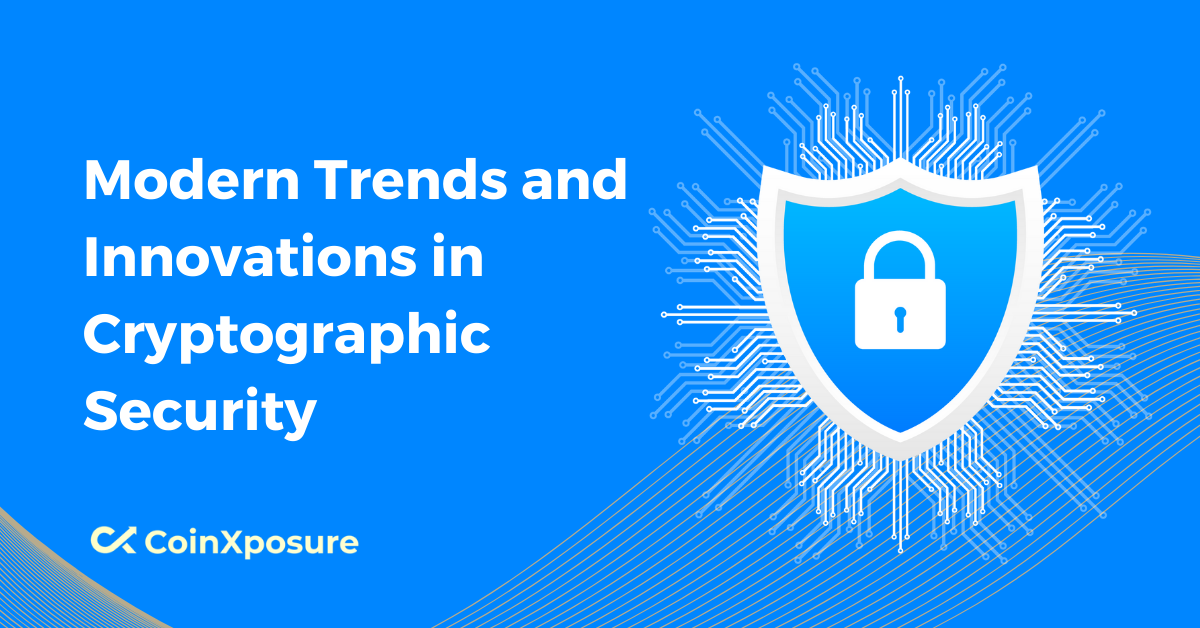
Modern Trends and Innovations in Cryptographic Security
Cryptography is vital to Cryptocurrency security. In this article, we will highlight the modern trends and innovations in Cryptographic security.
Businesses must keep private data safe to keep their customers’ trust. They must use cryptographic solutions to encrypt data, control encryption keys, sign digital objects, care for infrastructure, and do any mix to keep data secure.
When it comes to size, this is true for both large companies that issue cards and small FinTech startups.
On the back end, organizations in every part of the world economy rely on safe cryptographic systems that follow the rules. In the past, these systems were set up with hardware that was kept on-site.
However, more and more businesses are discovering the benefits of cloud-based security.
Along with more people using the cloud, there are also some fantastic innovations coming from smaller FinTechs, and there is a big push to ensure that data localization rules are followed in some places.
Futurex can see these security trends worldwide because it has offices and data centers everywhere.
What is Cryptography
Cryptography security uses codes to protect data and messages so that only the right people can read and process them. So, only approved people can get the information.
The word “crypt” means “hidden,” and “graphy” means “writing.”
The methods used in cryptography to keep data safe come from math ideas and rule-based processes called algorithms that change messages in complicated ways that are hard to figure out.
These algorithms create cryptographic keys, sign digital files, and check that they are correct to protect data privacy, online browsing, and private transactions like credit card and debit card transactions.
Techniques Used for Cryptography
The fields of cryptology and cryptanalysis are very similar to cryptography. It includes microdots, combining words with pictures, and other methods to hide data while it is being stored or sent.
However, in today’s computer-based world, cryptography is mainly linked to turning plaintext (standard text, also called cleartext) into ciphertext (a process called encryption) and back again (a process called decryption). People who work in this area are called cryptographers.
Objectives of Cryptography
Cryptography focuses on four primary objectives they include;
- Integrity
- Confidentiality
- Authentication
- Non-repudiation
Integrity
It is only possible to change the information while it is being stored or sent between the writer and the intended recipient by being caught.
Confidentiality
Only the intended recipient can access the information; no one else can see it.
Authentication
Both parties can verify the other’s identity and the information’s source and destination.
Non-repudiation
The person who makes or sends information can’t say that he doesn’t plan to send it at a later time.
Types of Cryptography
Cryptography generally has three types;
- Hash functions
- Symmetric key Cryptography
- Asymmetric key Cryptography
Hash Functions
None of the keys are used in this method. Based on the plain text, a hash value with a fixed length is determined. This makes it impossible to get back the contents of the plain text. A lot of operating systems protect passwords with hash functions.
Symmetric Key Cryptography
The person sending and receiving the message both use the same key to encrypt and decrypt the message. Using symmetric key systems is faster and easier, but the writer and receiver must find a safe way to trade keys.
There are a lot of different symmetric key cryptography systems, but the two most common ones are Data Encryption System (DES) and Advanced Encryption System (AES).
Asymmetric Key Cryptography
A pair of keys is used in this method to both encrypt and decrypt data. The public key of a receiver sets the encryption, and the private key of a receiver clears the encryption.
Private Key and Public Key are not the same thing. Anyone who knows the public key can decode it, but only the person who knows the secret key can figure out what it means.
The RSA algorithm is the most well-known asymmetric key cryptography technique.
Application of Cryptography in Cryptocurrency
When the Bitcoin protocol went live in 2009, it gave the world a new kind of money that is provided and protected in a very different way from how regular cash works.
Fiat currencies, like the US Dollar or the Japanese Yen, are backed by trust in the old banking system and released by each country’s central bank.
Any new currency goes into circulation based on a fluid monetary policy set by each country’s government.
There is some faith in the financial strength of each country and the armies that protect that strength and support stable currencies.
Cryptography is a branch of science used to protect and issue Bitcoin and all the other cryptocurrencies that came after it.
Ultimately, Bitcoin’s monetary policy is set by computers and can’t be changed by any person, company, or government.
People who use Bitcoin don’t trust the government or institutions; instead, they trust the protocol’s precise rules that make it work consistently, no matter the market price or sentiment.
Cryptography makes it possible for cryptocurrency deals to be safe, anonymous, and not based on trust.
This type of deal doesn’t require either party to know anything about the other party to go through with it, and it doesn’t require a third party to act as a go-between.
Bitcoin changed the public–private key method using a peer-to-peer network to ensure the transaction was real. The private key is used to make the public key.
This makes hashing a better way to protect personal information because anyone can’t figure out the private key just by looking at the public key.
Modern Trends and Innovations in Cryptographic Security
Since the COVID-19 pandemic, cybercrime has skyrocketed. A significant movement toward remote labor, online communication, and growing reliance on digital platforms occurred due to the global health crisis.
As a result, fraudsters now have more openings to prey upon unsuspecting individuals, companies, and government agencies.
This highlights the importance of putting in place, enforcing, complying with, and maintaining stringent security measures.
Cryptography is essential to establishing the digital trust necessary for internet security.
Here are some significant trends and innovations in Cryptographic Security;
- Data encryption and strong cryptography
- Hardware security module
- Key management system
- Tokenization
- Transport layer security
Data Encryption and Strong Cryptography
Organizations deploy many applications and services, necessitating strong cryptography with HSM-backed data encryption and key management.
The industry has attained a new level of maturity, with cryptography and key management becoming standard components of its ecosystems.
Hardware Security Module Adaptability
Hardware Security Modules (HSM) are like bank lockers: they are robust and tamper-proof hardware devices that keep your private information, like cryptographic keys, digital signatures, and certificates, safe and in order.
HSM follows the FIPS 140-2 standard. This standard is used as a standard for encryption hardware. It is tough to hack into an HSM, and entry is tightly controlled.
Many businesses employ more than one HSM to improve and strengthen their security.
Businesses are looking for solid options that meet the highest encryption standards and can also be changed to fit their needs, organizational structure, level of knowledge, and budget.
There are now three ways for organizations to set up their HSM: on-premises, cloud, and mixed.
Businesses and financial services firms are using cloud-based data protection architecture more and more.
Because of recent progress in using the cloud, following the rules, and having more ways to store data, as well as having HSMs available in the cloud.
Key Management System (KMS)
Any private information in banking must be kept safely, whether it’s credit or debit card numbers, login information, encryption keys, or something else. Encrypting data is the answer.
Using “encryption keys” to secure data would work, but how can you make sure that “encryption keys” are safe?
One answer is a key management system (KMS). KMS helps keep the keys safe (they can be backed up by an HSM if needed) and gives you a single place to control the encryption keys.
Tokenization
To protect sensitive information like PANs, PHI, PII, and similar numbers, tokenization transforms them into an anonymous string of characters called a “token.”
The generated ‘token’ is the same size and structure as the input token.
Transport Layer Security (TLS) Cryptographic Algorithm
There are two parts to how TLS systems work. The first step is the session start.
Before the protocol can make a shared secret key, the client must send private messages to the server using a public key encryption method, often RSA, when the session starts.
RSA is based on modular exponentiation, a costly computing method that makes up most of the processor cycles needed to create a TLS connection.
You can get even better security when you use techniques like perfect forward secrecy and an algorithm like Elliptic Curve Cryptography (ECC) together with RSA.
The bulk of the data is sent in the second part.
The protocols encrypt the data bits to keep them private, and they use a message authentication code (MAC) based on a cryptographic hash of the data to stop anything from changing the data while it’s being sent.
TLS bulk data transfers are protected by encryption and authentication methods. Putting them together can often make them work better overall. There are even “encryption + authentication” modes in some cipher systems, like AES-GCM.
Conclusion
Everything from your grocery list to your medical information, will almost certainly be encrypted.
This is a fantastic idea, but the topic of cryptography is highly unsettling, and there is a lot of effort being done right now to ensure that data can be safeguarded for the foreseeable future.





